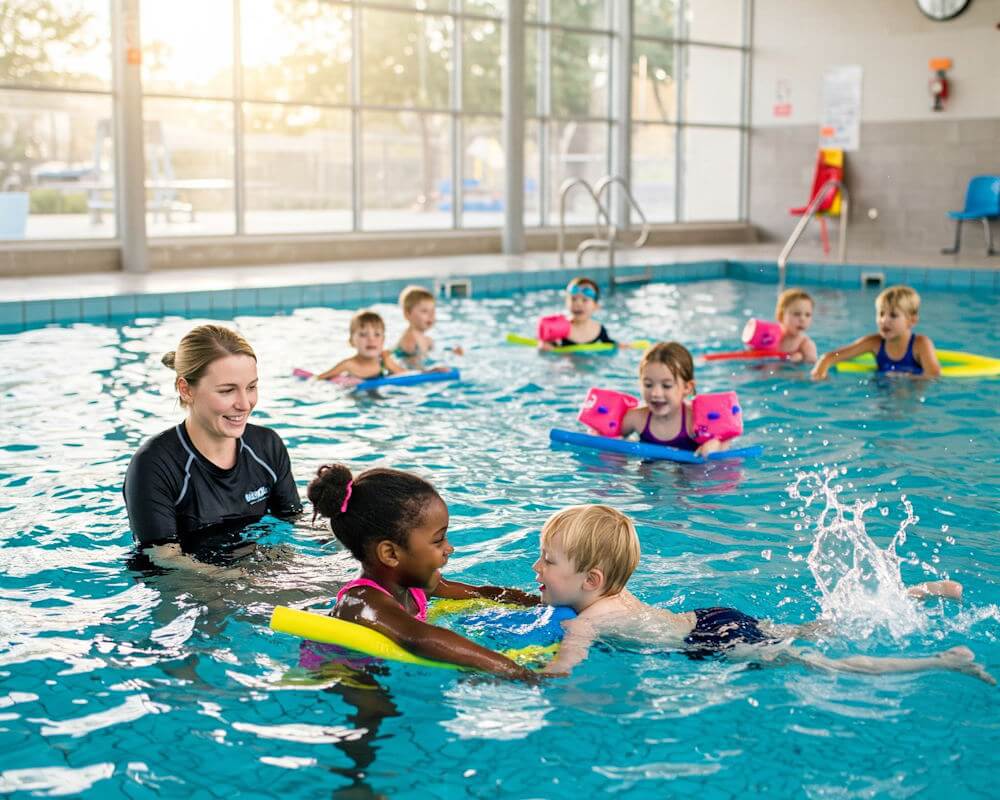Introduction to Swimming and Child Development
Swimming is widely recognized as an essential life skill; however, its role in child development extends far beyond mere survival in water. Engaging in swimming offers numerous benefits that promote physical, mental, and social growth in children. This multifaceted activity contributes significantly to their overall well-being, making it an invaluable component of a child’s upbringing.
Physical development is perhaps the most apparent outcome of swimming. As a low-impact exercise, swimming helps children enhance their cardiovascular fitness, build strength, and improve flexibility. Regular participation in swimming also contributes to maintaining a healthy weight, given the energy-intensive nature of the activity. Moreover, swimming serves as an effective tool for developing motor skills and coordination, as children learn to navigate the water through various strokes and techniques. These physical advancements lay the foundation for a child’s long-term health and wellness.
In addition to physical benefits, swimming plays a pivotal role in the mental development of children. Through swimming, children can experience stress relief and improved mood, largely due to the endorphins released during physical activity. Furthermore, swimming requires focus and concentration, which helps to develop cognitive skills and discipline. The rhythmic nature of swimming strokes can also aid in enhancing their ability to engage in mindfulness practices, beneficial for emotional regulation.
Socially, swimming fosters an environment for children to interact and build relationships. Whether in swimming classes, competitive teams, or casual pool gatherings, children learn teamwork, communication, and respect for others. Such social engagement not only cultivates friendships but also helps to boost self-esteem and confidence, as children experience shared successes and challenges.
Thus, swimming emerges as a profound and multifaceted contributor to child development, fostering growth across physical, mental, and social dimensions.
Physical Benefits of Swimming
Swimming offers a multitude of physical benefits that are particularly significant for children’s development. Engaging in swimming not only enhances cardiovascular fitness but also promotes muscle strength and overall endurance. These physical advantages stem from the resistance that water provides, which challenges children’s bodies in unique ways compared to land-based exercises. As they navigate through water, children develop a robust cardiovascular system as their heart and lungs work harder to supply oxygen to their muscles, thereby improving their stamina and overall physical health.
Furthermore, swimming encourages the development of key motor skills. Children must learn to coordinate their limbs while maintaining buoyancy and balance, which greatly enhances their physical coordination. The various strokes and techniques involved in swimming require children to focus on their movements, fostering greater body awareness. This awareness contributes to better posture and alignment, essential aspects of physical development that can benefit children in other sports and physical activities.
Flexibility is another vital component strengthened through swimming. The nature of swimming involves a wide range of motions, allowing children to stretch and extend their muscles in ways that are often less accessible in land-based activities. Regular swimming sessions can lead to improved joint flexibility, which is crucial for reducing the risk of injuries and enhancing overall physical capabilities.
In essence, the physical benefits of swimming extend beyond mere fitness. From improved cardiovascular function and muscle strength to enhanced coordination and flexibility, swimming serves as a comprehensive activity that promotes holistic physical development in children. It lays a solid foundation for a healthy lifestyle that can carry into adulthood, making swimming an invaluable aspect of child development.
Cognitive Development Through Swimming
Swimming, often regarded merely as a recreational activity, offers profound cognitive benefits that significantly contribute to child development. When children engage in swimming, they are not only exercising their bodies but also honing their mental faculties. The discipline required in mastering various swimming techniques fosters essential cognitive skills such as focus and concentration. As children learn to navigate the water, they must pay attention to their strokes, breathing patterns, and overall body movement. This level of awareness enhances their ability to concentrate and operate in a dynamic environment.
Moreover, swimming serves as a platform for improving problem-solving skills. Children often face challenges, whether it be overcoming fear of the water or mastering difficult techniques. These experiences encourage them to think critically and devise strategies to overcome obstacles, promoting mental agility. The need to adjust their tactics immediately in response to environmental factors, such as currents or water temperature, promotes adaptive thinking and resilience. Such cognitive flexibility is not limited to the pool; it translates into everyday life, enabling children to approach challenges with a problem-solving mindset.
Research has also established a robust link between physical activity and academic performance. In particular, swimming helps children increase blood flow to the brain, resulting in improved cognitive function. Studies show that children who participate in regular swimming activities often achieve better grades in school. The connection between a healthy body and a healthy mind underscores the importance of integrating physical exercise, like swimming, into children’s daily routines. As children progress in both their swimming skills and their cognitive abilities, they are better equipped to excel academically, showcasing the multifaceted benefits of this invaluable sport.
Emotional Well-being and Confidence Boost
Swimming serves as an effective avenue for enhancing a child’s emotional well-being and boosting self-confidence. Engaging in swimming activities fosters resilience as children confront and overcome various challenges inherent within the sport. Mastering new techniques, tackling distance swimming, or achieving a personal best result in a race can significantly bolster a child’s self-esteem. Each accomplishment in the pool reflects their ability to set goals and work diligently to achieve them, which underscores the importance of perseverance not only in swimming but also in other aspects of life.
Moreover, swimming is recognized as a powerful stress-reliever. The rhythmic nature of water activities encourages relaxation and provides a calming influence. For many children, swimming can act as a sanctuary where they learn to manage anxiety and express their emotions more openly. The gentle resistance of water offers a soothing environment, which is particularly beneficial for children experiencing emotional turmoil or stress in their daily lives. As a form of exercise, swimming also triggers the release of endorphins, our body’s natural mood elevators, further enhancing mental well-being.
In addition to these benefits, being part of a swimming class or team contributes to social interactions that foster feelings of belonging and acceptance. As children engage with peers in a supportive environment, they develop friendships and social skills, which are essential for emotional development. Consequently, the combination of physical activity, achievement, peer support, and stress alleviation offered through swimming creates a holistic approach to nurturing a child’s emotional health and confidence. This creates not just a better swimmer but a more confident and emotionally resilient individual ready to face life’s challenges.
Social Skills Development Through Swimming
Swimming serves as a powerful conduit for the development of social skills in children. Engaging in swimming lessons or joining a swim team provides various opportunities for young individuals to practice essential interpersonal skills. As children participate in group activities, they learn the value of teamwork, cooperation, and communication, all of which are fundamental components of healthy social interaction.
During swimming lessons, children are often placed in diverse teams, promoting a sense of belonging and camaraderie. As they navigate through structured practices and competitive events, swimmers must communicate effectively with one another, whether they are discussing techniques, encouraging teammates, or strategizing for races. This environment fosters strong bonds among peers, helping children cultivate friendships that can extend beyond the pool. The shared experience of overcoming challenges in the water can significantly enhance feelings of connection and support among young swimmers.
Moreover, swimming introduces children to various social dynamics. Interacting with peers of different backgrounds and skill levels encourages empathy and understanding. Regular participation in swimming activities helps children develop critical social competencies, such as conflict resolution and respect for others, as they learn to work alongside their teammates. Additionally, the supportive atmosphere of a swimming class allows children to experiment with social behaviors in a relatively safe setting, facilitating personal growth and confidence in their interactions.
As children progress in their swimming abilities, they often find themselves in mentorship roles, where they can assist newer swimmers. This not only reinforces their own skills but also nurtures a sense of responsibility and leadership. Altogether, swimming acts as a medium for enhancing social skills that are essential for overall child development, establishing connections that contribute to their emotional well-being and social competence.
Safety Awareness and Water Skills
Swimming is not only a valuable recreational activity but also an essential life skill that significantly contributes to child development, particularly in the realm of safety. As children learn to swim, they are introduced to crucial water safety skills necessary for preventing accidental drownings, which remain a leading cause of injury and death among young individuals. Understanding the dynamics of different water environments, including pools, rivers, and oceans, is critical in nurturing a child’s awareness and capabilities regarding safe interactions with water.
Children who undergo swimming lessons are educated about various safety protocols, such as never swimming alone and recognizing the signs of dangerous water conditions. Moreover, these experiences promote the recognition of buoyancy and the importance of using life jackets when appropriate. Mastering these safety practices instills a sense of responsibility in children, encouraging them to make informed decisions while engaging in water-related activities. This awareness not only reduces the likelihood of accidents but also enhances the overall security of their aquatic experiences.
Furthermore, as children become proficient swimmers, they naturally develop greater confidence in and around water. This increased self-assurance leads to a mindful approach to potential hazards, allowing them to assess situations with a more cautious eye. Confident swimmers are likely to engage in recreational swimming more frequently, leading to improved physical health and enhanced social interactions with peers.
Ultimately, learning to swim is instrumental in promoting safety awareness and water skills. It provides children with the tools they need to navigate aquatic environments effectively, thus laying the foundation for a more confident and cautious approach to water-related activities. As children develop these skills, they become not only safer individuals but also ambassadors of water safety among their peers, contributing to a culture of awareness that can ultimately save lives.
Lifelong Healthy Habits and Lifestyle Choices
Introducing swimming to children at an early age is a proactive step towards instilling lifelong healthy habits. Engaging in regular physical activity is critical for the development of children, influencing not only their physical health but also their emotional and social well-being. Swimming, in particular, offers numerous benefits that contribute to a healthier lifestyle as they grow older. For instance, swimming is a full-body workout that enhances cardiovascular health, builds muscle strength, and improves flexibility. These benefits lay the groundwork for an active life, promoting fitness well beyond childhood.
Furthermore, by making swimming a regular activity, children learn the importance of consistency and dedication. Establishing a routine around swimming can help them develop a structured approach to physical activities, which can lead to increased personal discipline. This discipline often translates to other areas of life, encouraging children to set and pursue goals. Whether it is achieving a specific swimming distance or improving their strokes, these goals can contribute to a sense of accomplishment and self-esteem that fosters positive, lifelong habits.
Moreover, the love for fitness that swimming can cultivate is integral to maintaining a healthy lifestyle. Children who experience the joy of swimming early in life are more likely to seek out similar physical activities as they age. This affinity for exercise can minimize the likelihood of sedentary behaviors that contribute to health issues later in life. Consequently, swimming serves not only as a fun recreational activity but also as a foundational element in developing an active lifestyle. By nurturing these positive associations with physical fitness, children are more equipped to make healthy lifestyle choices throughout their lives.
Swimming as a Creative Outlet
Swimming is not merely a sport; it serves as a dynamic platform for creative self-expression among children. Engaging in swimming allows young individuals to explore a plethora of techniques and strokes, each presenting an opportunity for imaginative interpretation. As children learn the various styles—such as freestyle, breaststroke, and butterfly—they learn to express themselves differently through movement. Each stroke can be performed with unique flair, enabling children to develop a personalized swimming style that reflects their personality.
Additionally, synchronized swimming is a vivid illustration of creativity in the aquatic environment. This form of swimming combines artistry with athleticism, as participants perform choreographed routines to music. Synchronized swimming encourages children to develop a keen awareness of rhythm and timing, fostering an appreciation for music and movement. This artistic endeavor requires collaboration and teamwork, allowing children to connect with their peers in imaginative ways, culminating in a shared artistic experience in the water.
Furthermore, swimming provides an avenue for the development of creative routines, whether for individual performance or group showcases. Children have the opportunity to invent sequences that highlight their strengths and imagination. These routines not only emphasize physical fitness but also challenge children to think creatively and strategically about their performances. As they experiment with different movements and formations, they enhance their problem-solving skills and boost their confidence.
In essence, swimming serves as a multifaceted creative outlet, stimulating artistic expression in children. By engaging in various swimming activities, they not only improve their physical abilities but also cultivate a rich tapestry of creative skills that will serve them well in various aspects of life. This blend of athleticism and artistry ultimately contributes to holistic child development, fostering both body and mind.
Conclusion: Embracing Swimming for Overall Child Development
In light of the comprehensive benefits outlined, swimming emerges as a vital component of child development. Engaging children in swimming activities not only fosters essential life skills but also supports their physical, emotional, and social growth. From improving motor skills and coordination to promoting cardiovascular health, the multifaceted advantages of swimming are undeniable.
Moreover, the psychological benefits associated with learning to swim—such as enhanced self-esteem, confidence, and resilience—underscore swimming as a positive influence on mental well-being. Children who swim often exhibit improved social interactions, as swimming lessons and team activities provide opportunities for making new friends and developing teamwork skills. These social interactions are essential in nurturing a child’s ability to communicate and collaborate effectively with peers.
Furthermore, swimming serves as a means of instilling safety awareness in children. Understanding water safety is a critical life skill that can prevent potential hazards related to water activities. Early exposure to swimming helps create a safe environment where children can enjoy water-based leisure activities while being equipped to handle dangers confidently.
Parents and caregivers are encouraged to recognize swimming not merely as a recreational activity but as an integral part of their children’s overall development strategy. The act of swimming offers a unique blend of physical exertion and mental stimulation, promoting holistic growth. As such, recognizing the role that swimming can play in a child’s life is essential. By introducing children to swimming at an early age, families can cultivate a positive association with water, ensuring their children thrive both in and out of the pool.



